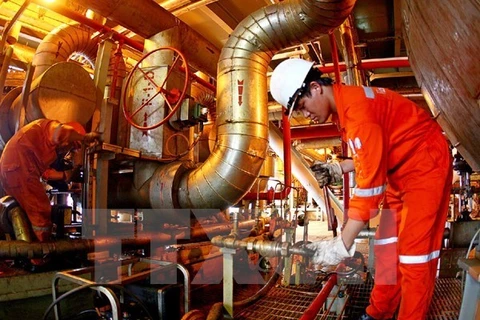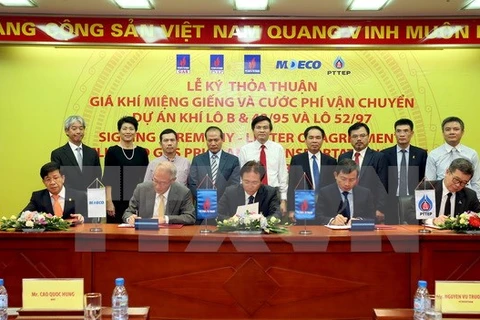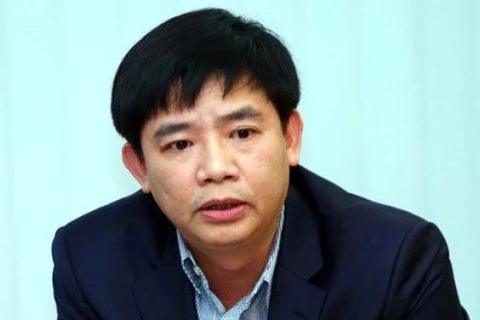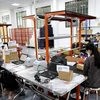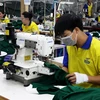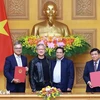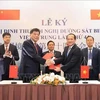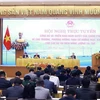 An oil rig of PVN affiliate Russia-Viet Nam Oil and Gas Exploration Joint Venture, (Vietsovpetro) at the Bach Ho (White Tiger) oil field off the coast of the southern province of Ba Ria- Vung Tau (Photo: VNA)
An oil rig of PVN affiliate Russia-Viet Nam Oil and Gas Exploration Joint Venture, (Vietsovpetro) at the Bach Ho (White Tiger) oil field off the coast of the southern province of Ba Ria- Vung Tau (Photo: VNA)Hanoi (VNA) – The oil and gas sector needs to adjust its production and business strategy so that it could compete with foreign rivals locally and internationally, said participants at a seminar in Hanoi on September 26.
They agreed that the sector should urgently build a human resources management system in accordance with international standards and put emphasis on the gas industry and consider it the driving force for the development of the whole sector.
At the same time, research units of the Vietnam National Oil and Gas Group (PetroVietnam) should focus on research and application of technology to reduce the cost of exploration, exploitation and to diversify processed oil products.
The oil and gas industry is one of the country’s key economic sectors, making important contributions to the national economy, but it is facing exceptionally tough challenges, especially in the context of deeper international integration, they said.
Vu Van Ha, deputy editor-in-chief of the Communist Review, told seminar participants that the oil and gas industry, represented by PetroVietnam, annually contributed 25-30 percent of the State’s budget revenues.
While state-owned enterprises (excluding the oil and gas industry) contributed about 42 percent of GDP, PetroVietnam separately accounted for 16–18 percent of GDP, the highest level of one company in the 2008-2015 period, Ha said.
In addition, the development of the oil and gas industry contributed to national energy security, playing an important role in Vietnam’s sea strategy and contributing to the protection of national sovereignty, he added.
Its achievements raised Vietnam position in the community of oil producing countries and contributed to enhancing the country’s international reputation, while boosting international cooperation and investment activities in key areas including exploration and exploitation, oil refineries, gas services and power services.
Overall, the industry helped enhance the value of oil and gas resources, promoting national industrialisation and modernisation and improving the competitive position of Vietnam’s oil and gas industry in the world, Ha said.
However, he added, the national oil and gas industry was facing tough goals.
Under the development strategy of the oil and gas industry towards 2025, the industry aims to annually increase oil and gas reserves to 35-40 million tonnes of oil equivalent, oil and gas exploitation will increase by 10-36 percent for each five-year period, of which the exploitation from overseas oil field must be 3 to 5 times higher than the current levels, the sector’s annual revenue is expected to grow by 10 to 15 percent.
"The future for the country’s oil and gas industry will be tougher as the major oil fields near the shores are close to exhausting production. The calling for foreign investment in oil and gas exploration will also be more difficult," Ha said.
Many large PetroVietnam projects lacked capital and access to credit while borrowing from international organisations is getting increasingly harder, he said. In addition, the company’s skilled human resources supply was becoming limited. Implementation of key projects abroad also faced obstacles, greatly affecting the achievements of short-term and long-term goals of the whole sector, Ha added.
Truong Dinh Tuyen, former minister of trade, said that under the free trade agreements and commitments that Vietnam had signed, import taxes on diesel and mazut would be zeroed out, also affecting the domestic oil and gas industry.
Thus, local suppliers would face stiff competition from not only foreign investors but also domestic importers due to the tariff elimination, Tuyen said.
With the establishment of the ASEAN Economic Community (AEC), in addition to the tariff reduction issue, there would be a shift in the labour force within the industry, leading to “brain drain” for the sector, he forecast. For example, some of PetroVietnam’s highly-skilled workers might move to other oil and gas groups from ASEAN countries if offered better working conditions.
The seminar was co-held by the Communist Review, a magazine of the Communist Party of Vietnam, and the Vietnam Union of Science and Technology Associations.-VNA
VNA
